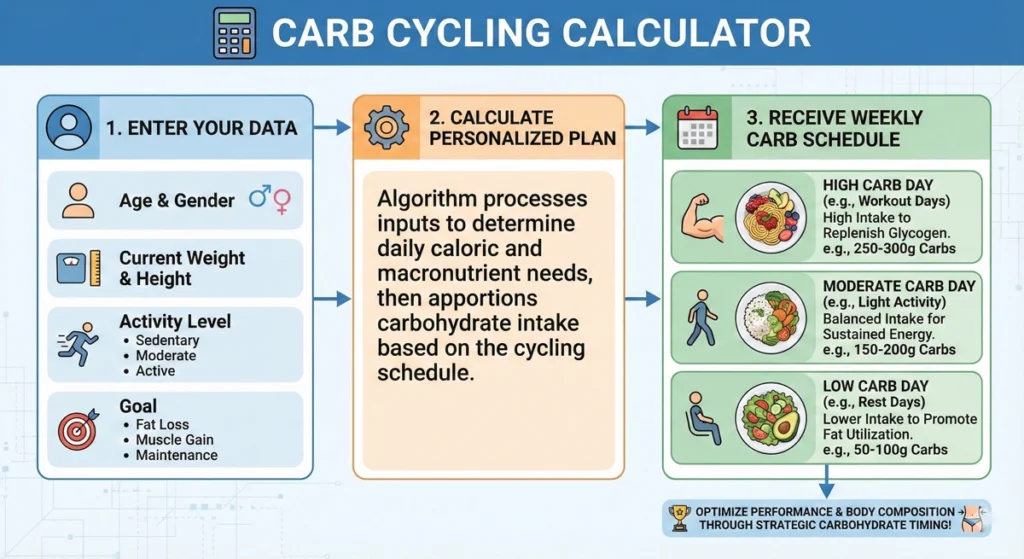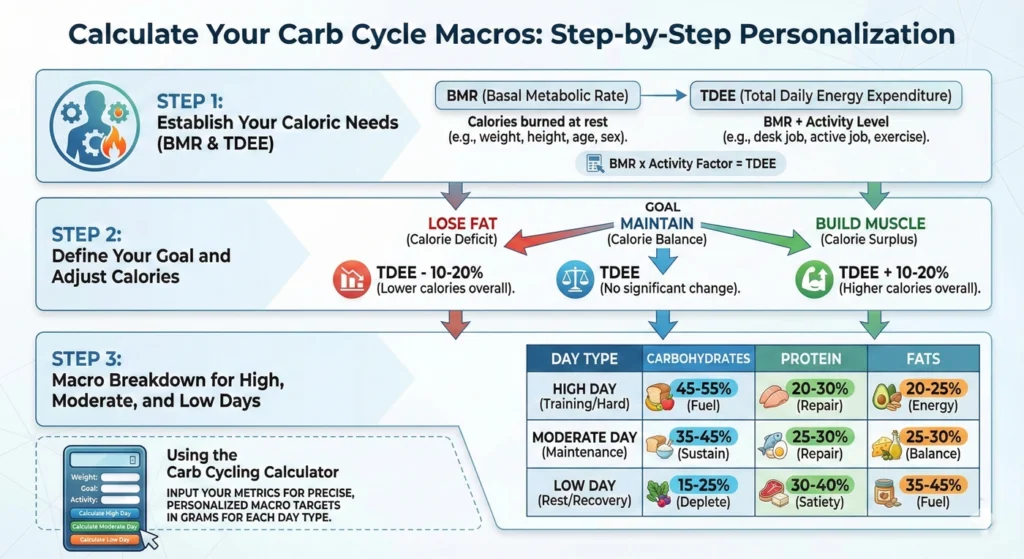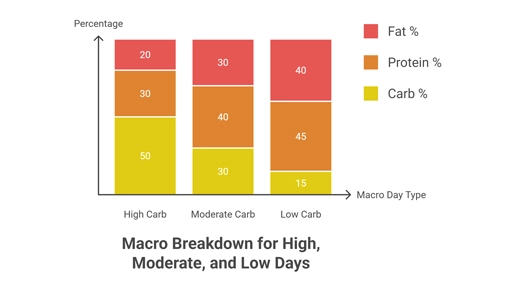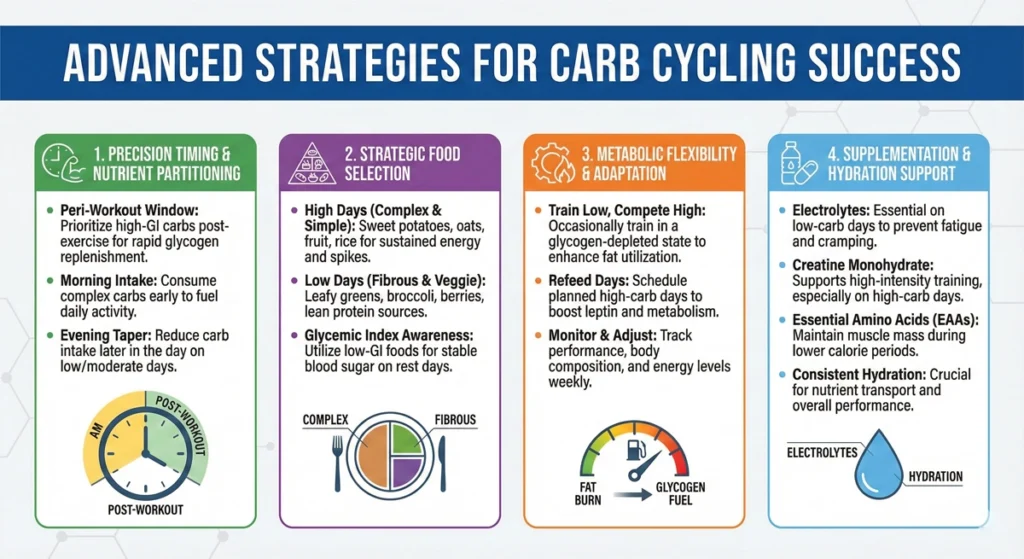Hey there! Tired of diets that make you choose between enjoying carbs and seeing results? Trust me, I’ve been there. That’s why I’m so excited to share the game-changer that is carb cycling – the nutritional strategy that lets you have your cake (literally) and eat it too… just on certain days!
Whether you’ve hit that frustrating weight loss plateau, you’re looking to shed fat while keeping your hard-earned muscle, or you just can’t face another day of saying “no thanks” to pasta, carb cycling might be your new best friend. In fact, it’s the flexible approach that works with your body’s needs rather than against them.
In this comprehensive guide, we’re diving into everything you need to know about carb cycling. I’m talking the science behind why it works, exactly how to calculate your personal carb targets (no guesswork!), a ready-to-use 7-day meal plan, and all the strategies to make it sustainable for the long haul.
By the end of this article, you’ll have the knowledge and tools to implement carb cycling in a way that fits your lifestyle and gets you those results you’ve been chasing. So grab a protein shake (or maybe a sweet potato if it’s your high-carb day), and let’s transform how you think about carbs forever!
- What is Carb Cycling: Alternating Macros for Maximum Results
- Calculate Your Carb Cycle Macros: Step-by-Step Personalization
- Your 7-Day Carb Cycling Meal Plan & Training Schedule
- Advanced Strategies for Carb Cycling Success
- The Role of Consistent Protein and Healthy Fats
- Tracking and Data Collection
- Avoiding Pitfalls
- Transitioning to Maintenance
- Frequently Asked Questions
- What is the main difference between Carb Cycling and the Ketogenic Diet?
- How long should I try a carb cycling regimen?
- Do I need a calculator to start carb cycling?
- What should my primary focus be on low-carb days?
- Are complex or simple carbs better for carb cycling?
- Conclusion: Is Carb Cycling Right For You?
What is Carb Cycling: Alternating Macros for Maximum Results

Core Definition and Mechanism
Think of carb cycling as your body’s nutritional rhythm section – you’re strategically drumming up your carbs when you need them and scaling back when you don’t. Unlike those “all or nothing” diets we’ve all failed at (looking at you, keto), carb cycling lets you enjoy those delicious carbs strategically.
Here’s the deal: you’ll eat more carbs on days when you’re crushing it at the gym (hello, energy for those squats!), and fewer carbs on rest days or when you’re just doing light activity. Meanwhile, your protein stays consistently high throughout – because nobody wants to lose those hard-earned muscles!
This approach essentially “tricks” your body in the best way possible. By fluctuating your carb intake, you prevent your metabolism from adapting and slowing down (which is what makes traditional diets fail after a few weeks). Consequently, it’s like keeping your body on its metabolic toes!
Proven Benefits (That Actually Make a Difference)
Carb cycling isn’t just another fad diet that your cousin’s friend’s sister tried once. In fact, it comes with some seriously impressive benefits backed by science:
- Fat Loss Without the Hangry Monster: Unlike traditional calorie-cutting diets that leave you dreaming about donuts 24/7, carb cycling helps maintain higher average calorie intake while still promoting fat loss. Moreover, those strategic high-carb days keep your leptin levels (your “fullness hormone”) from crashing.
- Muscles Stay Put (Or Even Grow): Since your protein intake remains high throughout, your muscles have the building blocks they need. Additionally, those carb-heavy days help drive nutrients into your muscles when they need it most.
- Your Insulin Becomes More Responsive: Regularly changing up your carb intake can improve how your cells respond to insulin, which is great news for your overall metabolic health and helps manage those energy crashes.
- Gym Performance That Doesn’t Suck: Let’s be honest – trying to crush a leg day while on a low-carb diet is like trying to drive a sports car with an empty gas tank. Fortunately, carb cycling ensures your hardest workouts are fueled properly.
- Hormone Harmony: This is especially clutch for women over 40, who might find that constant low-carb dieting wreaks havoc on hormonal balance. In contrast, the cycling approach gives your body periodic hormonal “breaks.”
Who Should Probably Skip Carb Cycling?
I’d love to say this works for everyone, but I’d be lying. However, some folks should proceed with caution or avoid carb cycling altogether:
- If you have diabetes or blood sugar regulation issues (insulin-dependent or not)
- If you have a history of disordered eating (the tracking involved can trigger unhealthy behaviors)
- If you’re pregnant or breastfeeding
- If you’re underweight or trying to gain weight
Always (and I mean ALWAYS) chat with your healthcare provider before starting any new dietary approach, especially if you have medical conditions. This isn’t just legal mumbo-jumbo – it’s genuinely important for your health.
Calculate Your Carb Cycle Macros: Step-by-Step Personalization

Let’s get down to the nitty-gritty of carb cycling calculations. I promise it’s not as complicated as deciphering your tax return!
Step 1: Establish Your Caloric Needs (BMR & TDEE)
First things first – you need to know how many calories your body needs just to exist (BMR) and then how many it needs with your activity level factored in (TDEE).
For BMR calculation:
Men: 66 + (6.23 × weight in pounds) + (12.7 × height in inches) – (6.8 × age in years)
Women: 655 + (4.35 × weight in pounds) + (4.7 × height in inches) – (4.7 × age in years)
Then multiply your BMR by your activity factor:
- Sedentary (little to no exercise): BMR × 1.2
- Lightly active (1-3 days of exercise): BMR × 1.375
- Moderately active (3-5 days of exercise): BMR × 1.55
- Very active (6-7 days of exercise): BMR × 1.725
- Extra active (physical job or twice-daily training): BMR × 1.9
For example, if you’re a 35-year-old woman who weighs 150 pounds, stands 5’6″ (66 inches), and hits the gym 4 times a week:
BMR = 655 + (4.35 × 150) + (4.7 × 66) – (4.7 × 35) = 1,429 calories
TDEE = 1,429 × 1.55 = 2,215 calories
Step 2: Define Your Goal and Adjust Calories
Now that you know your maintenance calories, let’s adjust based on your goals:
- Fat loss: Subtract 15-25% (start with 15% for sustainable results)
- Maintenance: Keep at your TDEE
- Muscle gain: Add 10-20% (start with 10% to minimize fat gain)
Using our example above for fat loss:
2,215 × 0.85 = 1,883 calories (rounded to 1,900)
However, here’s where carb cycling gets fun – you’re not eating the same calories every day!
Step 3: Macro Breakdown for High, Moderate, and Low Days
Here’s how to distribute your macros on different days (I’ve made this super practical with a real-world example for our 150 lb woman aiming for fat loss):
| Macro Day Type | Goal Focus | Carb % | Protein % | Fat % | Example (150 lb woman) |
|---|---|---|---|---|---|
| High Carb | Intense Training | 50% | 30% | 20% | 2,100 cal: 263g carb, 158g protein, 47g fat |
| Moderate Carb | Light Activity | 30% | 40% | 30% | 1,900 cal: 143g carb, 190g protein, 63g fat |
| Low Carb | Rest Days | 15% | 45% | 40% | 1,700 cal: 64g carb, 191g protein, 76g fat |
Notice how:
- Calories fluctuate slightly (higher on training days, lower on rest days)
- Protein stays relatively consistent (always around 1g per pound of bodyweight)
- Carbs and fats play seesaw – when one goes up, the other goes down

Using the Carb Cycling Calculator
If math makes your brain hurt (no judgment here!), there are plenty of free online calculators that can do the heavy lifting for you. Simply search for “carb cycling calculator” and input your stats. Furthermore, many apps like MyFitnessPal or Cronometer can also be configured to set different macro targets for different days of the week.
Remember: These calculations give you a starting point, not an exact science. Nevertheless, you’ll likely need to adjust based on how your body responds over the first few weeks.
Your 7-Day Carb Cycling Meal Plan & Training Schedule

Structuring Your Week (Cycle Templates)
There’s no one-size-fits-all approach to setting up your week. Here are some popular templates you can try:
Option 1: Match Your Workout Intensity (My personal favorite!)
- High-Carb Days: Schedule these on your most intense workout days (leg day, HIIT training, long runs)
- Moderate-Carb Days: Use these for upper body or moderate intensity training
- Low-Carb Days: Save these for rest days, yoga, or light walks
Option 2: The Classic 4-Day Rotation
- 2 Low-Carb Days
- 1 Moderate-Carb Day
- 1 High-Carb Day
- Repeat
Option 3: Weekend Warrior Special
- Monday-Friday: Alternate between low and moderate carb days based on workout schedule
- Saturday: High-carb day (coincides with your longest/hardest workout)
- Sunday: Low-carb day (rest and recovery)
The key is matching your highest carb intake with your highest energy output. Therefore, it’s like making sure you fill up your car before a road trip, not after you’ve already arrived!
Quality Macronutrient Sources for Carb Cycling
High-Carb Day Foods (Your Fuel-Up Friends)
- Complex Carbs: Sweet potatoes, oats, quinoa, brown rice, beans, lentils
- Fruits: Bananas, apples, berries, oranges
- Veggies: All varieties (yes, even the starchy ones are okay today!)
- Protein: Lean sources like chicken breast, egg whites, white fish, protein powder
- Fats: Keep minimal – just what comes naturally in your foods
Low-Carb Day Foods (Your Fat-Burning Buddies)
- Protein: Same as high-carb days, plus fattier options like salmon, whole eggs, steak
- Healthy Fats: Avocados, olive oil, nuts, seeds, nut butters
- Veggies: Non-starchy varieties like leafy greens, broccoli, cauliflower, peppers
- Carbs: Limited to veggies and perhaps a small serving of berries
Pro tip: Fiber doesn’t impact your blood sugar the same way other carbs do, so don’t stress about fiber content in veggies on low-carb days. Those brussels sprouts aren’t going to derail your plan!
Sample Meal Ideas by Carb Day
High-Carb Day Menu Example:
- Breakfast: Oatmeal with banana, berries, and a scoop of protein powder
- Mid-Morning Snack: Greek yogurt with a small handful of granola
- Lunch: Burrito bowl with brown rice, black beans, chicken breast, salsa, and veggies
- Pre-Workout: Banana with a tablespoon of honey
- Post-Workout: Protein shake with milk and a serving of quick-digesting carbs like white rice
- Dinner: Baked salmon with sweet potato and roasted vegetables
Low-Carb Day Menu Example:
- Breakfast: Veggie omelet with avocado
- Mid-Morning Snack: Handful of almonds and a string cheese
- Lunch: Large salad with grilled chicken, olive oil dressing, and a variety of non-starchy veggies
- Afternoon Snack: Celery with almond butter
- Dinner: Zucchini noodles with turkey meatballs and pesto
- Evening: Protein shake made with water and a tablespoon of MCT oil
Advanced Strategies for Carb Cycling Success

The Role of Consistent Protein and Healthy Fats
Here’s a mistake I see all the time: people get so fixated on cycling their carbs that they forget about the other macronutrients. Don’t fall into this trap!
Keep protein steady at around 0.8-1g per pound of bodyweight every single day. This is your muscle insurance policy. Without adequate protein, you might end up losing muscle along with fat, which is exactly what we’re trying to avoid.
Let fats be your energy balancer. When carbs go down, fats should come up to make sure you’re not starving yourself. Those healthy fats are crucial for hormone production, brain function, and keeping you feeling satisfied when carbs are low.
Think of it this way: protein is consistent, carbs fluctuate based on activity, and fats fill in the calorie gaps.
Tracking and Data Collection
I know tracking food isn’t everyone’s idea of a good time (understatement of the century), but it’s pretty crucial when starting carb cycling. You don’t have to do it forever, but for at least the first month, consider tracking:
- Food intake: Using an app like MyFitnessPal or Cronometer
- Body measurements: Weight is fine, but also consider waist/hip/chest measurements
- Energy levels: Rate your workouts and daily energy on a scale of 1-10
- Sleep quality: Are you sleeping better or worse?
- Mood: How are you feeling emotionally?
This data will help you fine-tune your approach. Maybe you’ll discover you feel amazing on moderate-carb days but terrible on super-low-carb days – that’s valuable information that might suggest you need to adjust your lower end.
Avoiding Pitfalls
Even the best carb cycling plan can fall apart if you ignore these common pitfalls:
Skipping the “big rocks” of health: No nutrition plan can outwork poor sleep, chronic stress, or dehydration. Make sure you’re sleeping 7-9 hours, managing stress, and drinking water like it’s your job.
Getting tunnel vision on macros: Yes, hitting your macros matters, but food quality matters too! 150g of carbs from vegetables, fruits, and whole grains will affect your body very differently than 150g from processed junk.
Expecting perfection: You will have days where you can’t stick to the plan. Maybe there’s a birthday party or a business dinner. That’s life! One off-plan meal (or even day) won’t derail your progress if you get right back on track.
Ignoring micronutrients: Changing your eating pattern can sometimes create vitamin or mineral gaps. Consider a quality multivitamin, and focus on nutrient-dense foods rather than just hitting macro targets.
Transitioning to Maintenance
Carb cycling isn’t meant to be a forever diet – it’s a tool to help you reach specific goals. Once you’ve hit your target, here’s how to transition:
- Gradually increase carbs across all days: Start by adding about 20g of carbs to your low days, then assess for 1-2 weeks before making more adjustments.
- Reduce the “swing” between days: Eventually, your high and low days will get closer together in terms of carb intake.
- Consider a modified approach: Many people find success with a simplified version for maintenance – perhaps just having one higher carb day on your most active day and moderate carbs the rest of the time.
Remember: The best diet is one you can sustain long-term. The skills you learn from carb cycling (like matching nutrition to activity and being mindful of macros) can serve you well even if you’re not strictly following the protocol forever.
Frequently Asked Questions
What is the main difference between Carb Cycling and the Ketogenic Diet?
While both approaches can be effective for fat loss, they’re quite different! Carb cycling includes scheduled high-carb days to refuel your muscles and reset hormones, whereas the ketogenic diet maintains very low carb intake (typically under 50g daily) to keep you in ketosis. Carb cycling tends to be more flexible and often better for active individuals or those who struggle with the all-or-nothing nature of keto. Plus, I don’t know about you, but I get pretty cranky without my occasional sweet potato!
How long should I try a carb cycling regimen?
There’s no one-size-fits-all answer, but most people see results within 2-3 weeks. Many structured programs like the 21 Day Fix EXTREME use carb cycling for short, focused periods. I typically recommend giving it a solid 4-week trial before deciding if it’s right for you. After that, you can continue if you’re seeing positive results, or transition to a different approach if it’s not working for your body or lifestyle.
Do I need a calculator to start carb cycling?
While you don’t absolutely need a calculator, it sure makes life easier! Calculating your personalized macros removes guesswork and ensures you’re hitting appropriate targets based on your specific body and goals. Think of it like using GPS versus a paper map – sure, both can get you there, but one makes the journey much smoother! At minimum, you need some basic math to determine your protein needs and how to adjust carbs and fats on different days.
What should my primary focus be on low-carb days?
On low-carb days, shift your focus to quality proteins and healthy fats while emphasizing fiber-rich vegetables. These days are designed to enhance fat burning by keeping insulin levels lower and encouraging your body to tap into fat stores for energy. Make sure you’re getting enough electrolytes (sodium, potassium, magnesium) as lower carb intake can flush these out of your system. And don’t stress about “hidden carbs” in leafy greens and non-starchy vegetables – their fiber content and nutrient density make them perfect for low-carb days.
Are complex or simple carbs better for carb cycling?
For most of your carb intake, focus on complex, unrefined carbohydrates like whole grains, starchy vegetables, and legumes. These provide sustained energy, fiber, vitamins, and minerals. However, simple carbs do have their place – specifically right before or after intense workouts on high-carb days when your muscles can use that quick-acting glucose. As a general rule: complex carbs for daily meals, simple carbs for strategic workout fuel.
Conclusion: Is Carb Cycling Right For You?
We’ve covered a lot of ground in this carb cycling journey! From calculating your personal macro needs to structuring your week and avoiding common pitfalls, you now have all the tools to give this approach an honest try.
Carb cycling isn’t magic (sorry to burst that bubble!), but it is smart nutrition that works with your body’s natural rhythms and energy needs. The beauty of this approach lies in its flexibility – you get to enjoy higher carb days when your body can use them most efficiently, while still creating the calorie deficit needed for fat loss through your lower carb days.
What I love most about carb cycling is that it teaches you to tune into your body. You’ll start noticing how different carb levels affect your energy, your workouts, your mood, and even your sleep. This awareness is invaluable no matter what nutritional approach you follow in the future.
Remember that your carb cycling calculator numbers are starting points, not commandments written in stone. Don’t be afraid to adjust as you go – the best plan is always the one you can stick with consistently.
If you’re tired of all-or-nothing diets and ready for a more balanced approach to nutrition that still delivers results, give carb cycling a honest 4-week trial. Track your progress, be patient with yourself, and remember why you started.
Your body is incredibly adaptable – sometimes that works against you (hello, weight loss plateaus!), but with carb cycling, you’re using that adaptability to your advantage. So go ahead – calculate those macros, plan those meals, and discover what strategic carb manipulation can do for your body and performance.
Here’s to finding a sustainable way to eat that fuels your workouts, supports your goals, and yes – still lets you enjoy those delicious carbs. You’ve got this!
References:
- Burke, L. M., Hawley, J. A., Wong, S. H., & Jeukendrup, A. E. (2011). Carbohydrates for training and competition. Journal of Sports Sciences, 29(sup1), S17-S27.
- Heilbronn, L. K., Civitarese, A. E., Bogacka, I., Smith, S. R., Hulver, M., & Ravussin, E. (2005). Glucose tolerance and skeletal muscle gene expression in response to alternate day fasting. Obesity Research, 13(3), 574-581.
- Coyle, E. F. (2004). Fluid and fuel intake during exercise. Journal of Sports Sciences, 22(1), 39-55.
- Phillips, S. M., & Van Loon, L. J. (2011). Dietary protein for athletes: from requirements to optimum adaptation. Journal of Sports Sciences, 29(sup1), S29-S38.